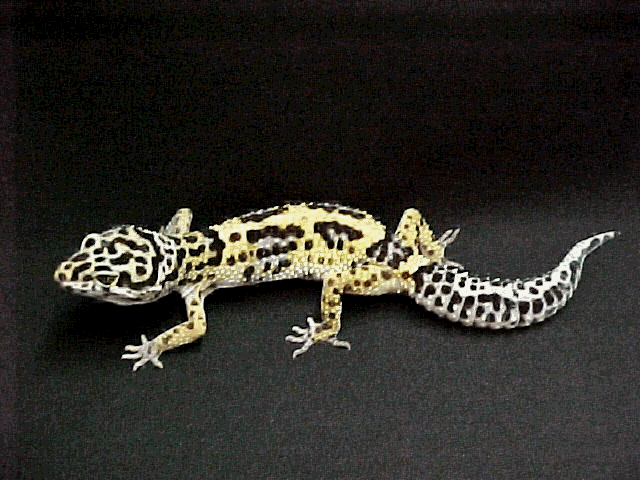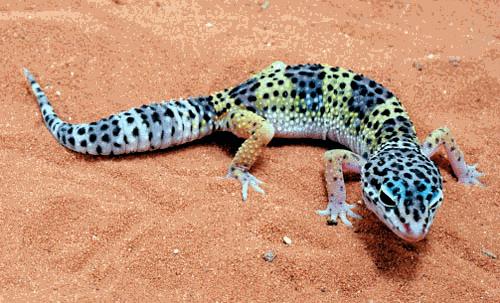
Hatchlings-
The hatchlings are very hardy and
easy to care for, especially
compared to hatchlings of many
other lizard species. They do
quite well on a diet of crickets
of an appropriate size (for
hatchlings, 1/8 to 1/4 inch crickets or
smaller). The right size food item
will be no longer than half the width
of the lizards own head. It is
important to supply vitamins and
minerals to your growing gecko.
This can be accomplished by “gut-loading”
crickets by feeding them such
items as orange slices, carrots,
salad greens, fish flake food, or
a commercially available cricket
food prior to giving them to your
lizard. Additionally, the crickets
can be dusted (coated in powder)
with a quality commercial
vitamin/mineral powder just before
providing them to your gecko to
eat. Hatchlings should be fed
every day or two to maintain a
healthy growth rate. It is a good
idea to vary the diet from time to
time by offering some other insect
prey such as mealworms, waxworms,
or butterworms. Remember to keep
the prey size appropriate and use
these worms sparingly, as they are
mostly fatty or chitinous. I
recommend keeping a small water
bowl available at all times, just
be sure to clean it regularly.
Adults- The adults are
maintained in much the same way.
Using a larger prey item feedings
can be scaled back to two to three
times a week. They don’t need
vitamin supplementation quite as
often either, maybe with every
other to every third feeding. You
can offer adult geckos an
occasional pinkie mouse to vary
the diet and supply a more
complete diet. This is good for
breeding females as well, to keep
on a little extra body weight to
compensate for reproductive energy
expenditures.
 General-
The leopard gecko comes from the
dry, rocky, plains and steppes
regions of Afghanistan, Pakistan,
and northwestern India. They are
most active at dusk and dawn,
usually sleeping throughout most
of the daytime hours. A 10-gallon
tank will comfortably house an
adult gecko or even a pair of
geckos. I recommend a plastic shoe
or sweater box for the hatchlings
or juveniles only because it makes
it easier for them to capture prey
in the smaller area. Paper towels
or newspaper make cleaning quick
and easy and eliminates the
possibility of ingesting any sand
or gravel that may impede
digestion and kill the gecko. The
adults, however, can be kept on a
sand (or Calci-Sand) substrate
without problems. Add some rocks,
branches, and small plants to make
an interesting landscape for your
gecko to explore. Provide geckos
with an area where they can hide,
such as a rock shelter or
hide-box. Keep a heat pad, or
thermostat controlled heat rock
available at all times on one end
of the tank. Lighting is a matter
of personal choice since the
geckos don’t seem to care, just
be sure your geckos always have
access to shelter from the light
and heat if they so choose.
General-
The leopard gecko comes from the
dry, rocky, plains and steppes
regions of Afghanistan, Pakistan,
and northwestern India. They are
most active at dusk and dawn,
usually sleeping throughout most
of the daytime hours. A 10-gallon
tank will comfortably house an
adult gecko or even a pair of
geckos. I recommend a plastic shoe
or sweater box for the hatchlings
or juveniles only because it makes
it easier for them to capture prey
in the smaller area. Paper towels
or newspaper make cleaning quick
and easy and eliminates the
possibility of ingesting any sand
or gravel that may impede
digestion and kill the gecko. The
adults, however, can be kept on a
sand (or Calci-Sand) substrate
without problems. Add some rocks,
branches, and small plants to make
an interesting landscape for your
gecko to explore. Provide geckos
with an area where they can hide,
such as a rock shelter or
hide-box. Keep a heat pad, or
thermostat controlled heat rock
available at all times on one end
of the tank. Lighting is a matter
of personal choice since the
geckos don’t seem to care, just
be sure your geckos always have
access to shelter from the light
and heat if they so choose.
Other Helpful Info:
̃
Always buy a healthy captive
bred animal and learn as much as
you can from the source that you
are buying it from, such as age,
sex, what is it eating, etc.
̃
Find a local veterinarian who is
knowledgeable about reptiles before
any problems arise!
̃
Buy a good book about Leopard
Geckos or at least a book with a
decent section about these
animals and keep it on hand for
reference. This care sheet
contains only initial
information to get you started
and is by no means complete.
̃
Enjoy your leopard gecko! These
are fantastic and rewarding
pets.